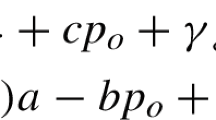Abstract
This paper describes the spatial distribution of customer demand, supply of customer services and facility investment, as the outcome of a three-level game-like interaction between customers (e.g., shoppers), suppliers (e.g., retailers) and developers (e.g., landlords). Treating both the suppliers and developers at each centre as competitors, oligopolistic equilibria of the Nash-Stackelberg type are developed, and conditions for their existence and uniqueness established. Uncertain customer demand is specified in probabilistic terms, representing the suppliers' perception of expected customer behaviour.
Similar content being viewed by others
References
Berge, C. 1957. Theorie Generale des Jeux à n Personne.Memoriale des sciences Mathematiques, Fasc 138.
Harris, B., and Wilson, A. G. 1978. Equilibrium values and dynamics of attractiveness terms in production-constrained spatial interaction models.Environment and Planning A, 10: 371–388.
Intriligator, M. D. 1971.mathematical Optimization and Economic Theory. New Jersey: Prentice Hall.
Johansson, B. 1978.Contributions to Sequential Analysis of Oligopolistic Competition. Memorandum No. 73, Nationalekonomiska Institutionen, University of Gothenburg.
Karnani, A. 1983. Stochastic cost-volume profit analysis in a competitive oligopoly.Decision Sciences, 14, 2: 187-193.
Lakshmanan, T. R., and Hansen, W. G. 1965. A retail market potential model.Journal of the American Institute of Planners, 31: 134–143.
Leonardi, G. 1978. Optimal facility location by accessibility maximizing.Environment and Planning A, 10: 1287–1305.
Leonardi, G. 1981. A unifying framework for public facility location problems.Environment and Planning A, 13, Part 1: 1001–1028, Part 2: 1085–1108.
Rijk, F. A. and Vorst, A. C. F. 1983. On the uniqueness and existence of equilibrium points in an urban retail model.Environment and Planning A, 15: 475–482.
Roy, J. R., and Johansson, B. 1984. On planning and forecasting the location of retail and service activity.Regional Science and Urban Economics, 14: 433–452.
Roy, J. R., and Lesse, P. F. 1983. Planning models for non-cooperative situations: a two-player game approach.Regional Science and Urban Economics, 13: 205–221.
Roy, J. R. 1983. Estimation of singly-constrained nested spatial interaction models.Environment and Planning B, 10: 269–274.
Roy, J. R. 1985. On forecasting choice between dependent spatial alternatives.Environment and Planning B, in press.
Sherali, H. D., Soyster, A. L., and Murphy, F. H. 1983. Stackelberg-Nash-Cournot equilibria: characterizations and computations.Operations Research, 31, 2: 253–276.
Sherali, H. D. 1984. A multiple leader Stackelberg model and analysis.Operations Research, 32, 2: 390–404.
Shubik, M. 1959.Strategy and Market Structure: Competition, Oligopoly and the Theory of Games. New York, Wiley.
Truong, T. P. 1982. A theoretical analysis of choice, demand and time allocation: with reference to travel. Ph.D. dissertation, School of Economics and Financial Studies, Macquarie University, Sydney.
Author information
Authors and Affiliations
Rights and permissions
About this article
Cite this article
Roy, J., Johansson, B. & Leonardi, G. Some spatial equilibria in facility investment under uncertain demand. Papers of the Regional Science Association 56, 215–228 (1985). https://doi.org/10.1007/BF01887914
Issue Date:
DOI: https://doi.org/10.1007/BF01887914




